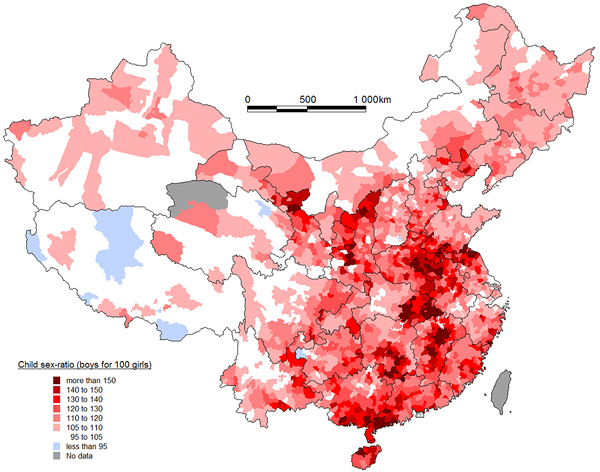
A recent issue of The New Atlantis features the article “The Global War Against Baby Girls,” by Nicholas Eberstadt, on the epidemic of sex selection. In countries that value the lives of women less than men, gender discrimination now means not just that women are likely to be treated poorly, but that they might not be allowed to live at all. Baby girls in these countries are habitually being killed because of their sex (typically in the womb but also in many cases after birth).Eberstadt’s article goes into some detail about the demographics of this phenomenon: it’s happening in scores of developing countries across the world, and, perhaps counterintuitively, is much more prevalent among affluent families. Minimum estimates place the number of baby girls eliminated based on their gender in the range of 30 million; more comprehensive estimates place the total upwards of 160 million.
and Sex Ratios of the Population Age 0-4:
China, 1953-2005 (boys per 100 girls)
| Year | Sex Ratio at Birth |
Sex Ratio, Age 0-4 |
| 1953 | — | 107.0 |
| 1964 | — | 105.7 |
| 1982 | 108.5 | 107.1 |
| 1990 | 111.4 | 110.2 |
| 1995 | 115.6 | 118.4 |
| 1999 | 117.0 | 119.5 |
| 2005 | 118.9 | 122.7 |
So what do our friends, the bastions of potential biotech progress, have to say about this very actual biotech present? The transhumanist and libertarian economist Robin Hanson has weighed in on Eberstadt’s article on his blog. Hanson has previously turned his moral acumen to subjects like how we should forget the 9/11 attacks because they killed an insufficient number of people to matter. When Hanson responds to Eberstadt’s article, however, the number of lives lost doesn’t seem to matter, even though in this case it can be expressed as large percentages of affected countries’ populations.Instead, Hanson asks the really important question, which is what a high school student in the second week of his introductory macroeconomics course would say about all this:
A simple supply and demand analysis says that selective abortion both expresses a preference for boys and causes a reduction in that preference as wives become scarce. In South Korea this process is mostly complete, with excess boys down from 15% in the 1990s to 7% today (with ~5% as the biologically natural excess).
That’s a nice story, except that South Korea is the only country where there has been a clear reversal. Hanson doesn’t mention the dozens of other countries where the ratio of male to female births has increased steadily, without significant reversal, since the early 1980s. Perhaps this issue isn’t clarified by forcing it inside “a simple supply and demand analysis.” But let’s not let facts stand in the way of our favorite theories. Reported child (0-4) sex ratio in China by county, 2000Or perhaps the reversal just hasn’t kicked in yet for those countries. So history should bear out Hanson’s idea. Can you think of any societies that have selectively exterminated a certain class of their members? Now, how did those exterminations come to an end: was it because those societies suddenly began to value what they had made scarce?Hanson elaborates:
Reported child (0-4) sex ratio in China by county, 2000Or perhaps the reversal just hasn’t kicked in yet for those countries. So history should bear out Hanson’s idea. Can you think of any societies that have selectively exterminated a certain class of their members? Now, how did those exterminations come to an end: was it because those societies suddenly began to value what they had made scarce?Hanson elaborates:
This topic offers a good example of a conflict between sending desired signals and getting desired outcomes. Since parents who selectively abort girls show favoritism toward boys, it can feel quite natural to signal your opinion that women have equal value by condemning such parents, and favoring policies to discourage their actions. Not doing so can make you seem anti-female. Yet since via supply and demand the abortions chosen by these parents directly increase the value of women, then all else equal discouraging their abortions reduces the value of women. So if you want women to have higher value, your signal is counter-productive.
You might think that the people who devalue girls so much that they kill them are the ones who, well, devalue them. But you’d be wrong. The best thing you can do to help the cause of girls is to get rid of more of them. Got it?Maybe I’ve been hasty in my take on Hanson’s analysis. Let’s see how he wraps this up:
Of course it is far from clear that the relative value of males and females should be the main consideration here. One might instead argue that if male lives are more pleasant overall, it is good that we create more of them instead of female lives. Yes, supply and demand may eventually equalize the quality of male and female lives, but until then why not have moves [more] lives that are more pleasant?
One goes through life aware that some people, even respected intellectuals, think these things — but you figure they at least know better than to say them in public. Did I mention that the name of Hanson’s blog is “Overcoming Bias”? And he doesn’t seem to be kidding, either. If some other people think your life is not worth living, then that makes it actually not worth living, and the rational, beneficial thing to do from a public and economic standpoint is to end it.Transhumanists claim they’re bringing us away from moral slavery and toward rational enlightenment. Libertarian economists claim to offer tools to make peoples’ lives better and more free. To borrow a line from Alan Jacobs: How are they doing so far?

Hey! Me too!:
http://ieet.org/index.php/IEET/more/hughes20070510/
J. Hughes
If there are fewer women than men, or vice versa, it will be irrelevant for some, and others will adapt. Individual reproductive expectations, and sexual desires and identities can and do adapt to availability. The evidence is clear that sexual preference is only in part biologically determined, and that situational factors play some role. Many men become “situationally gay” in boys’ schools, prisons or the military.
Now this is a future we can look forward to!
Sounds like James mostly agrees with me: " As desperate men relax their expectations about what kind of bride is acceptable, and women become more socially mobile, this will increase the options for all women in sex ratio-shifted societies."